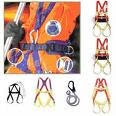
Harnesses can become deadly whenever an operative is suspended for durations of over five minutes in an upright posture with the legs relaxed straight beneath the body. After five minutes they are highly likely to be unconscious - but operatives attending the scene often don't realise the seriousness of the situation and, 15 minutes later a dead body is hauled up. The cause of this problem is called 'suspension trauma'. Suspension Trauma - Orthostatic IntoleranceUnless the operative is rescued promptly using established safe procedures, suspension trauma caused by orthostatic intolerance could occur and result in serious or fatal injury as the brain, kidneys and other organs are deprived of oxygen.Most users of fall protection equipment, as well as rescue personnel and health and safety professionals are unaware of the hazard of suspension trauma. Venous pooling - The need to faint and fall overDeath from suspension trauma is caused by orthostatic intolerance and is the result of venous pooling. This can occur any time a person is required to stand still for prolonged periods and may be worsened by heat and dehydration. A well-known example of orthostatic intolerance is that of the soldier who faints while standing to attention for any length of time. Major blood vessels pass through the muscles in the legs. The movement of these muscles assists circulation by squeezing the blood back up towards the heart. If the muscles stop moving, as in the case of the soldier, gravity pulls the blood down into the legs.Eventually, enough blood accumulates (venous pooling) so that return blood flow to the right chamber of the heart is reduced as the heart can only pump the blood available, so its output begins to fall. The heart then speeds up to maintain sufficient blood flow to the brain but, if the blood supply to the heart is restricted enough, the higher pulse and faster breathing is ineffective and the body abruptly slows the heart. The result is fainting.The moment the soldier loses consciousness he collapses and becomes horizontal so the time spent in a vertical position while unconscious is minimal and, as blood flow improves - the result of being horizontal - the soldier returns to consciousness and recovery is likely to be rapid.When a person is suspended in a harness in which their legs are immobile, unlike the fainting soldier the person does not or cannot naturally move into a horizontal position, then gravity pulls blood into the lower legs.
In a harness, the operative can't fall into a horizontal posture, so the reduced heart rate causes the brain's blood supply to fall below the critical level. During excessive venous pooling, cardiac output and arterial pressure fall to levels which can critically reduce the quantity and/or the quality of oxygenated blood flowing to the brain. What to look out for - If a worker is suspended in a harnessThe possible signs and symptoms of orthostatic intolerance can start to be seen in 2/3 minutes and can include: Ø faintnessØ NauseaØ BreathlessnessØ DizzinessØ SweatingØ unusually low heart rateØ unusually low blood pressureØ palenessØ hot flushesØ "graying"Ø loss of vision Ø increased heart rateOwing to the possibility of damage to vital organs - the result of suspension trauma - it is recommended that all recovered casualties should be taken to their nearest Accident & Emergency Unit for examination and observation.Being aware of the demands for fast, simple and effective rescue, Leading Edge Supplies Ltd have developed a range of products and courses specifically designed for rescue in the construction industry, allowing typical site operatives to rescue conscious and unconscious casualties in under ten minutes.
Leading Edge Height Safety Rescue training course has been designed with our extensive knowledge and experience of construction sites in mind. We understand the operative capabilities, the scope of works involved in a project package and the constraints on access and restrictions and we have developed our training course accordingly.Being aware of the demands for fast, simple and effective rescue,when working at height Leading Edge Safety have developed a range of products and courses specifically designed for at height rescue in the construction industry, allowing typical site operatives to rescue conscious and unconscious casualties in under five minutes.
In a harness, the operative can't fall into a horizontal posture, so the reduced heart rate causes the brain's blood supply to fall below the critical level. During excessive venous pooling, cardiac output and arterial pressure fall to levels which can critically reduce the quantity and/or the quality of oxygenated blood flowing to the brain. What to look out for - If a worker is suspended in a harnessThe possible signs and symptoms of orthostatic intolerance can start to be seen in 2/3 minutes and can include: Ø faintnessØ NauseaØ BreathlessnessØ DizzinessØ SweatingØ unusually low heart rateØ unusually low blood pressureØ palenessØ hot flushesØ "graying"Ø loss of vision Ø increased heart rateOwing to the possibility of damage to vital organs - the result of suspension trauma - it is recommended that all recovered casualties should be taken to their nearest Accident & Emergency Unit for examination and observation.Being aware of the demands for fast, simple and effective rescue, Leading Edge Supplies Ltd have developed a range of products and courses specifically designed for rescue in the construction industry, allowing typical site operatives to rescue conscious and unconscious casualties in under ten minutes.
Leading Edge Height Safety Rescue training course has been designed with our extensive knowledge and experience of construction sites in mind. We understand the operative capabilities, the scope of works involved in a project package and the constraints on access and restrictions and we have developed our training course accordingly.Being aware of the demands for fast, simple and effective rescue,when working at height Leading Edge Safety have developed a range of products and courses specifically designed for at height rescue in the construction industry, allowing typical site operatives to rescue conscious and unconscious casualties in under five minutes.
Author: drew700x




Comments :
0 komentar to “Working at Height Will your safety harness kill you”
Posting Komentar